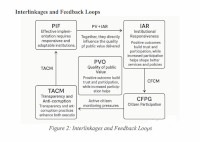Reframing Government Evaluation: Introducing the Government Accountability and Delivery Effectiveness Index (GADEI)for Improved Performance Measurement
Main Article Content
Abstract
Despite the proliferation of governance indicators in recent decades, a persistent gap remains in capturing the real-time performance of governments in delivering policy outcomes, responding to citizen needs, and ensuring institutional accountability. This paper proposes the Government Accountability and Delivery Effectiveness Index(GADEI)—a multidimensional, adaptive, and impact-oriented framework designed to assess how effectively governments translate policy commitments into tangible public value. GADEI is structured around five interrelated pillars: Policy Implementation Fidelity, Institutional Agility, Public Value Outcomes, Transparency and Anti-Corruption Metrics, and Citizen Feedback. By linking governance evaluation to observable delivery, responsiveness, and trust metrics, GADEI provides a dynamic and action able lens for assessing state effectiveness. The framework holds significant utility for informing fiscal policy, guiding public sector reform, and enhancing democratic accountability, particularly in contexts where traditional input- or perception-based measures fall short.
Downloads
Article Details
Section

This work is licensed under a Creative Commons Attribution-NonCommercial 4.0 International License.
How to Cite
Share
References
1. Acemoglu, D., & Robinson, J. A. (2012). Why nations fail: The origins of power, prosperity, and poverty. Crown Publishing.
2. Andrews, M., Pritchett, L., & Woolcock, M. (2017). Building state capability: Evidence, analysis, action. Oxford University Press.
3. Ansell, C., & Gash, A. (2008). Collaborative governance in theory and practice. Journal of Public Administration Research and Theory, 18(4), 543–571. https://doi.org/10.1093/jopart/mum032
4. Besley, T., & Persson, T. (2011). Pillars of prosperity: The political economics of development clusters. Princeton University Press.
5. Brinkerhoff, D. W., & Wetterberg, A. (2016). Gauging the effects of social accountability on services, governance, and citizen empowerment. Public Administration Review, 76(2), 274–286. https://doi.org/10.1111/puar.12399
6. Buchanan, J. M., & Tullock, G. (1962). The calculus of consent: Logical foundations of constitutional democracy. University of Michigan Press.
7. Kaufmann, D., Kraay, A., & Mastruzzi, M. (2009). Governance matters VIII: Aggregate and individual governance indicators 1996–2008. World Bank Policy Research Working Paper No. 4978. https://doi.org/10.1596/1813-9450-4978
8. Knack, S. (2006). Measuring corruption in Eastern Europe and Central Asia: A critique of the cross-country indicators. World Bank Policy Research Working Paper No. 3968. https://doi.org/10.1596/1813-9450-3968
9. North, D. C. (1990). Institutions, institutional change and economic performance. Cambridge University Press.
10. Osborne, D., & Gaebler, T. (1992). Reinventing government: How the entrepreneurial spirit is transforming the public sector. Addison-Wesley.
11. Rodrik, D. (2004). Getting institutions right. CESifo DICE Report, 2(2), 10–15.
12. Sen, A. (1999). Development as freedom. Oxford University Press.
13. Thomas, M. A. (2010). What do the worldwide governance indicators measure? European Journal of Development Research, 22(1), 31–54. https://doi.org/10.1057/ejdr.2009.32
14. Transparency International. (2023). Corruption perceptions index. https://www.transparency.org/en/cpi/2023
15. UNDP. (1990–2023). Human development reports. United Nations Development Programme. https://hdr.undp.org
16. World Bank. (2023). Worldwide governance indicators. https://info.worldbank.org/governance/wgi


